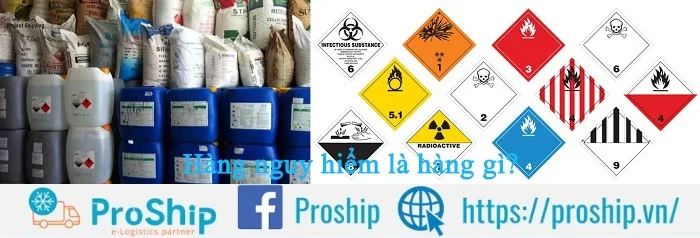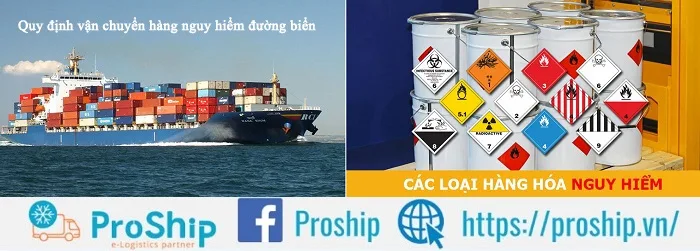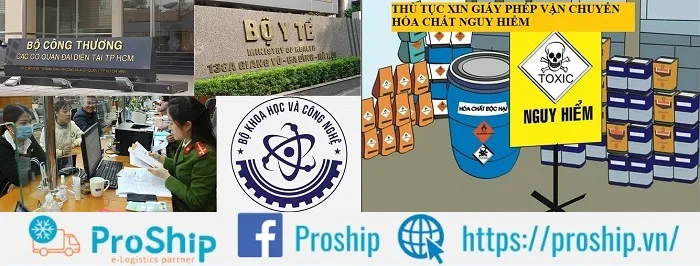x Doanh nghiệp bạn có lô hàng nguy hiểm cần vận chuyển đường biển?
x Bạn muốn tìm hiểu các quy định, điều luật liên quan khi vận chuyển hàng nguy hiểm theo đường biển ra sao? Có phức tạp, rắc rối không?
x Bạn cần cập nhật danh sách các loại hàng nguy hiểm? Đơn vị nào có thẩm quyền cấp phép vận chuyển mặt hàng đặc thù này?
Trong khuôn khổ bài chia sẻ này, Proship.vn chúng tôi sẽ trình bày những quy định đối với việc vận chuyển hàng nguy hiểm bằng đường biển, khái niệm và phân loại hàng nguy hiểm. Quý Doanh nghiệp quan tâm cần cập nhật nội dung bên dưới để hỗ trợ hiệu quả cho công việc cũng như biết được đơn vị nào có thẩm quyền cấp Giấy phép vận chuyển hàng hóa nguy hiểm.
📦 Hotline Liên Hệ Vận Chuyển
🧭 Miền Trung
Hàng hóa nguy hiểm là mặt hàng gì? Gồm những gì?
Khái niệm hàng hóa nguy hiểm
Vận tải hàng hóa là quá trình giao nhận hàng hóa ở nơi gửi đến chỗ nhận gồm các nhiên liệu, nguyên vật liệu bán, thành phẩm mà ngành giao thông vận tải đường biển nhận vận chuyển.
Hàng hóa nguy hiểm là những loại hàng hóa trong quá trình lưu kho, bảo quản, vận chuyển, xếp dỡ, giao nhận phát sinh sự cố nguy hiểm như bùng nổ, gây độc hại, phá hủy phương tiện vận tải, phát tán phóng xạ gây ảnh hưởng đến môi trường sống và tính mạng con người. Khi vận chuyển Hàng hải, hàng nguy hiểm gây phá hủy thiết bị, phương tiện và làm mất trọng tâm, lật hoặc chìm tàu.
Ngoài ra, theo Luật Giao thông đường bộ định nghĩa: “Hàng hóa nguy hiểm là hàng hóa chứa các chất nguy hiểm khi chở trên đường có khả năng gây nguy hại tới tính mạng, sức khỏe con người, môi trường, an toàn và an ninh quốc gia”.
Dựa vào các khái niệm trên, hàng hóa được xem là hàng nguy hiểm khi:
- Chứa chất độc hại, ảnh hưởng sức khỏe và tính mạng con người;
- Hàng hóa gây ô nhiễm môi trường, mất trật tự an ninh quốc gia;
- Hàng hóa gây nguy hiểm cho phương tiện đường biển trong quá trình vận chuyển.

Danh sách các loại hàng hóa nguy hiểm
Các hàng hóa nguy hiểm gồm có 9 loại sau:
- Loại 1: Chất và vật liệu gây nổ công nghiệp, chất nổ;
- Loại 2: Khí ga dễ và không dễ cháy, độc hại, không độc hại;
- Loại 3: Chất lỏng dễ cháy và chất nổ lỏng khử nhậy;
- Loại 4: Chất đặc dễ cháy, nổ đặc khử nhậy, chất tự phản ứng, tự bốc cháy và các chất gặp nước sản sinh khí ga dễ cháy;
- Loại 5: Hợp chất oxit hữu cơ và oxi hóa;
- Loại 6: Chất lây nhiễm và độc hại;
- Loại 7: Chất phóng xạ;
- Loại 8: Chất ăn mòn;
- Loại 9: Chất và hàng gây nguy hiểm khác.
>>Xem thêm: Rủi ro trong vận chuyển hàng đường biển
Quy định vận tải hàng nguy hiểm đường biển, cần biết
Proship Logistis với kinh nghiệm về vận tải container Nội địa, nay chia sẻ về các quy định liên quan tới vận chuyển hàng nguy hiểm bằng đường biển MỚI NHẤT năm 2024:
Quy định về bảo quản, bao bì hàng nguy hiểm
Theo khoản 1 Điều 27 Nghị định 60/2016/ NĐ-CP về điều kiện đầu tư và kinh doanh trong lĩnh vực tài nguyên và môi trường có quy định bảo quản, bao bì cho hàng nguy hiểm sau:
- Bao bì có khả năng chống sự ăn mòn, không phản ứng hóa học với các chất chứa bên trong, không bị hoen gỉ; chống thấm, kín đáo và chắc chắn để tránh trường hợp rò rỉ hàng nguy hiểm ra môi trường khi vận chuyển trong điều kiện bình thường hoặc xảy ra sự cố.
- Nếu cá nhân hoặc tổ chức tự đóng gói hàng nguy hiểm, phải tiến hành thực nghiệm và kiểm tra chất lượng bao bì trước khi đưa vào sử dụng để hạn chế rơi lọt, tò rỉ chất độc hại khi chuyên chở bằng đường biển.
- Các loại bao bì, vật chứa sau khi dùng xong cần bảo quản riêng nhằm đáp ứng các quy định của nhà nước.
- Ngoài ra, bao bì phải phù hợp với hàng bên trong và miễn nhiễm với các loại hóa chất hoặc tác động của hàng nguy hiểm.
Tiêu chuẩn về phương tiện vận tải
Khi muốn vận chuyển hàng hóa, đặc biệt là hàng nguy hiểm, phương tiện cần đủ điều kiện tham gia giao thông:
- Các bộ phận, thiết bị chuyên dùng của phương tiện phải đạt tiêu chuẩn do Bộ quản lý ngành quy định tại khoản 2 Điều 10 đề ra. Đồng thời, phương tiện tham gia kiểm định và có giấy chứng nhận phương tiện cơ giới đường bộ đủ điều kiện vận chuyển hàng nguy hiểm.
- Các phương tiện chở hàng hóa nguy hiểm phải dán biểu tượng nguy hiểm lên mặt hàng đang vận chuyển và cần làm sạch, xóa bỏ hết chúng khi không tiếp tục vận chuyển.
- Nghiêm cấm sử dụng tàu thuyền không đáp ứng tiêu chuẩn kĩ thuật để vận chuyển hàng hóa nguy hiểm.

Trách nhiệm các bên liên quan trong vận tải hàng nguy hiểm
Đối với các bên khi tham gia quá trình vận chuyển hàng hóa bằng đường biển cần có trách nhiệm như đã thỏa thuận trong hợp đồng trước đó.
Chủ hàng cần hỗ trợ tuyệt đối và thanh toán đúng thời hạn với bên vận chuyển. Còn bên cung cấp dịch vụ có trách nhiệm toàn bộ quá trình vận chuyển, đảm bảo an toàn của hàng hóa và đưa hàng đến đúng thời gian và địa điểm quy định.
Quá trình bốc dỡ đúng cách hàng hóa nguy hiểm
Hàng hóa nguy hiểm một khi bị rò rỉ ra môi trường sẽ gây nên những hậu quả nghiêm trọng cho sức khỏe và tính mạng của con người. Vì vậy, quá trình bốc dỡ hàng cần thực hiện bài bản, đúng cách để tránh tác động đến chúng.
Mỗi cá nhân hay tổ chức tham gia xếp dỡ hàng hóa nguy hiểm trên tàu và lưu kho, bãi cần tuân thủ đúng những quy định của từng mặt hàng nguy hiểm hoặc trong thông báo của bên chủ hàng.
Người thủ kho, người áp tải trực tiếp hướng dẫn và giám sát quá trình xếp, dỡ hàng để hàng hóa được bốc dỡ đúng phương pháp.
📦 Hotline Liên Hệ Vận Chuyển
🧭 Miền Trung
Giấy phép khi vận chuyển hàng nguy hiểm gồm những gì, ai cấp phép?
Để có thể vận chuyển hàng nguy hiểm bằng đường biển hoặc bất cứ phương thức vận tải nào thì trước tiên phải xin cấp Giấy phép vận chuyển từ các Bộ phụ trách (phía Đơn vị vận tải sẽ xin cấp phép). Tùy mức độ liên quan và mục đích sử dụng mà mỗi Bộ chỉ có quyền cấp phép một số nhóm hàng hóa nguy hiểm đã nêu trên:
1. Bộ Khoa học và Công nghệ có quyền cấp giấy phép vận chuyển cho hàng hóa nguy hiểm nhóm 5, nhóm 7 và nhóm 8;
2. Bộ Công an có quyền cấp giấy phép vận chuyển cho hàng hóa nguy hiểm nhóm 1, nhóm 2, nhóm 3, nhóm 4 và nhóm 9;
3. Bộ Y tế có quyền cấp giấy phép để vận chuyển hóa chất độc hại dùng trong y tế, các hóa chất diệt khuẩn, diệt côn trùng trong lĩnh vực gia dụng;

4. Bộ Công thương có quyền cấp giấy phép vận tải cho hàng hóa nguy hiểm nhóm 2, nhóm 3 và các chất xăng dầu, khí đốt, các chất độc nguy hiểm;
5. Bộ Nông nghiệp và Phát triển Nông thôn có quyền cấp giấy phép vận chuyển cho các hóa chất bảo vệ thực vật.
6. Đặc biệt, đối với việc vận chuyển hàng nguy hiểm phục vụ quân sự, quốc phòng và lợi ích quốc gia, an ninh lực lượng vũ trang thì sẽ được quy định định bởi Bộ trường Bộ Quốc Phòng và Bộ trưởng Bộ Công An.
Vận chuyển hàng nguy hiểm bằng đường biển cùng những quy định liên quan tới phương tiện, quy cách bảo quản và đóng gói bao bì hàng hóa, trách nhiệm của các bên liên quan cũng như cách thức bốc dỡ hàng nguy hiểm đã được Proship Logistics cập nhật.
Vậy, nếu Doanh nghiệp bạn có nhu cầu sử dụng Dịch vụ vận chuyển container đường biển Nội địa hàng nguyên FCL giá rẻ, liên hệ ngay 0909 344 247 để được tư vấn và hỗ trợ A – Z từ đóng gói, phân loại, vận chuyển hàng…tới thủ tục giấy tờ.
📦 Hotline Liên Hệ Vận Chuyển
🧭 Miền Trung

